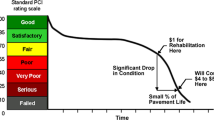Abstract
This study develops a fuzzy mathematical analysis called the Fuzzy Analytic Hierarchy Process (FAHP) for Pavement Condition Assessment (PCA) and prioritization by considering the functional and structural evaluation of pavement as well as traffic volume. The Pavement Condition Index (PCI), characteristic deflection, International Roughness Index (IRI), and Commercial Vehicles Per Day (CVPD) are identified as four performance indicators for PCA. Software for executing FAHP is developed using Python, providing performance indicator values as inputs, and the deliverable is the Fuzzy Pavement Priority Index (FPPI). The selected stretches of National Highway (NH) 66, State Highway (SH) 75, SH 61, and SH 51, in the Thrissur district of Kerala, India is prioritized from the Maintenance and Rehabilitation (M&R) aspect based on FPPI values from the software. FAHP, being a combination of the Analytic Hierarchy Process (AHP) and fuzzy logic, measures the degree of consistency in the judgments provided by a decision-maker and captures the subjectivity inherent in human judgment. The results demonstrate that the collected data serves as a good estimator to prioritize the stretches for M&R purposes. The proposed method, being a more scientific approach, serves as a base model for PCA and the developed software delivers FPPI values suitable for performing the differential ranking of stretches.





Similar content being viewed by others
Data availability statement
Not applicable.
References
Elhadidy, A. A., El-badawy, S. M., & Elbeltagi, E. E. (2019). A simplified pavement condition index regression model for pavement evaluation. International Journal of Pavement Engineering. https://doi.org/10.1080/10298436.2019.1633579
Singh, A. P., Sharma, A., Mishra, R., Wagle, M., & Sarkar, A. K. (2018). Pavement condition assessment using soft computing techniques. International Journal of Pavement Research and Technology, 11(6), 564–581. https://doi.org/10.1016/j.ijprt.2017.12.006
Farhan, J., & Fwa, T. F. (2009). Pavement maintenance prioritization using analytic hierarchy process. Journal of the Transportation Research Board, 2093, 12–24. https://doi.org/10.3141/2093-02
Ahmed, S., Vedagiri, P., & Krishna-Rao, K. V. (2017). Prioritization of pavement maintenance sections using objective based Analytic Hierarchy Process. International Journal of Pavement Research and Technology, 10(2), 158–170. https://doi.org/10.1016/j.ijprt.2017.01.001
J. Arliansyah, T. MARUYAMA, and O. TAKAHASHI, “a Development of Fuzzy Pavement Condition Assessment,” J. Mater. Conc. Struct. Pavements, JSCE, vol. 61, no. 746, pp. 275–285, 2003, doi: https://doi.org/10.2208/jscej.2003.746_275.
Chandran, S., Isaac, K. P., & Veeraragavan, A. (2007). Prioritization of low-volume pavement sections for maintenance by using fuzzy logic. Transportation Research Record, 1(1989), 53–60. https://doi.org/10.3141/1989-06
Sun, L., & Gu, W. (2011). Pavement condition assessment using fuzzy logic theory and analytic hierarchy process. Journal of Transportation Engineering, 137(9), 648–655. https://doi.org/10.1061/(ASCE)TE.1943-5436.0000239
Ali, A., Heneash, U., Hussein, A., & Eskebi, M. (2022). Predicting Pavement Condition Index using fuzzy logic technique. Infrastructures. https://doi.org/10.3390/infrastructures7070091
Sinha, A., Hagawane, P., & Engineering, C. (2020). Method comparison of pavement condition rating based on IRC & ASTM Guidelines. International Research Journal of Engineering and Technology, 7(5), 2520–2524.
Iskandar, D., Hadiwardoyo, S. P., & Sumabrata, R. J. (2020). Fuzzy logic based life cycle cost analysis model for preventive road maintenance by considering user costs. International Journal of Engineering Research and Technology, 13(4), 725–733. https://doi.org/10.37624/ijert/13.4.2020.725-733
Al-Haddad, A. H. A., & Al-Haydari, I. S. J. (2018). Modeling of flexible pavement serviceability based on the fuzzy logic theory. Journal of Transportation Engineering Part B: Pavements, 144(2), 04018017. https://doi.org/10.1061/jpeodx.0000026
Mahmood, M., Rahman, M., Nolle, L., & Mathavan, S. (2013). A fuzzy logic approach for pavement section classification. International Journal of Pavement Research and Technology, 6(5), 620–626. https://doi.org/10.6135/ijprt.org.tw/2013.6(5).620
FWA, T. and Shanmugam, R. (1998). 4th International Conference on Managing Pavements (1998). 4 th Int. Conf. Manag. Pavements, p. 15.
Suryoto, Siswoyo, D. P., & Setyawan, A. (2017). The evaluation of functional performance of national roadway using three types of Pavement Assessments Methods. Procedia Engineering, 171, 1435–1442. https://doi.org/10.1016/j.proeng.2017.01.463
Liu, Y., Eckert, C. M., & Earl, C. (2020). A review of fuzzy AHP methods for decision-making with subjective judgements. Expert Systems with Applications., 161, 113738. https://doi.org/10.1016/j.eswa.2020.113738
Nazifah, S., Abidin, Z. and Jaffar, M. M. (2018). Analytic Hierarchy Process (AHP) as a Tool in Asset Allocation Analytic Hierarchy Process (AHP) as a Tool for Asset Allocation. https://doi.org/10.1063/1.4801150.
Saaty, T. L. (2008). Decision making with the Analytic Hierarchy Process. International Journal of Services Sciences, 1(1), 83–98. https://doi.org/10.1504/ijssci.2008.017590
Sandra, A. K., & Sarkar, A. K. (2013). Development of a model for estimating International Roughness Index from pavement distresses. International Journal of Pavement Engineering. https://doi.org/10.1080/10298436.2012.703322
Author information
Authors and Affiliations
Corresponding author
Ethics declarations
Conflict of Interest
The authors declare that they have no conflict of interest.
Appendix- FAHP for Stretch VT1 of SH 75 Using Software
Appendix- FAHP for Stretch VT1 of SH 75 Using Software
Calculation started !
Input values: ['93', '0.73', '3.85', '1944']
Given constants: wz = [0.31, 0.273, 0.284, 0.133]
Final constant = [0.333, 0.267, 0.2, 0.133, 0.067]
PCI: [0.466, 0.0, 0.0, 0.0, 0.0]
Deflection: [0.0, 0.675, 1.0, 0.234, 0.0]
IRI: [0.075, 0.961, 0.289, 0.0, 0.0]
CVPD: [0.0, 0.707, 0.0, 0.0, 0.0]
Sum of normalized rows: [[1.0, 0, 0, 0, 0], [0, 0.354, 0.524, 0.123, 0], [0.057, 0.725, 0.218, 0, 0], [0, 1.0, 0, 0, 0]]
Constant values: Sum of normalized rows
Multiplying normalized matrices with a constant row
M1: [[0.31 0.273 0.284 0.133]]
M2: [[1. 0. 0. 0. 0.]
[0. 0.354 0.524 0.123 0.]
[0.057 0.725 0.218 0. 0.]
[0. 1. 0. 0. 0.]]vx = M1.M2: [[0.326188 0.435542 0.204964 0.033579 0.]]
Multiplying the above answer with a constant row matrix
Final constant row matrix: [[0.333 0.267 0.2 0.133 0.067]]
Transformed matrix: [[0.326188]
[0.435542]
[0.204964]
[0.033579]
[0.]]
FPPI = Final constant row x transformed matrix
Final Answer: {'fuzzy_set': '', 'fppi': 0.270369125}
Rights and permissions
Springer Nature or its licensor (e.g. a society or other partner) holds exclusive rights to this article under a publishing agreement with the author(s) or other rightsholder(s); author self-archiving of the accepted manuscript version of this article is solely governed by the terms of such publishing agreement and applicable law.
About this article
Cite this article
Smrudu, T.K., Sanjay Kumar, V.S. & Akkara, J. Pavement Condition Assessment Using Fuzzy Analytic Hierarchy Process. Int. J. Pavement Res. Technol. (2023). https://doi.org/10.1007/s42947-023-00335-6
Received:
Revised:
Accepted:
Published:
DOI: https://doi.org/10.1007/s42947-023-00335-6




